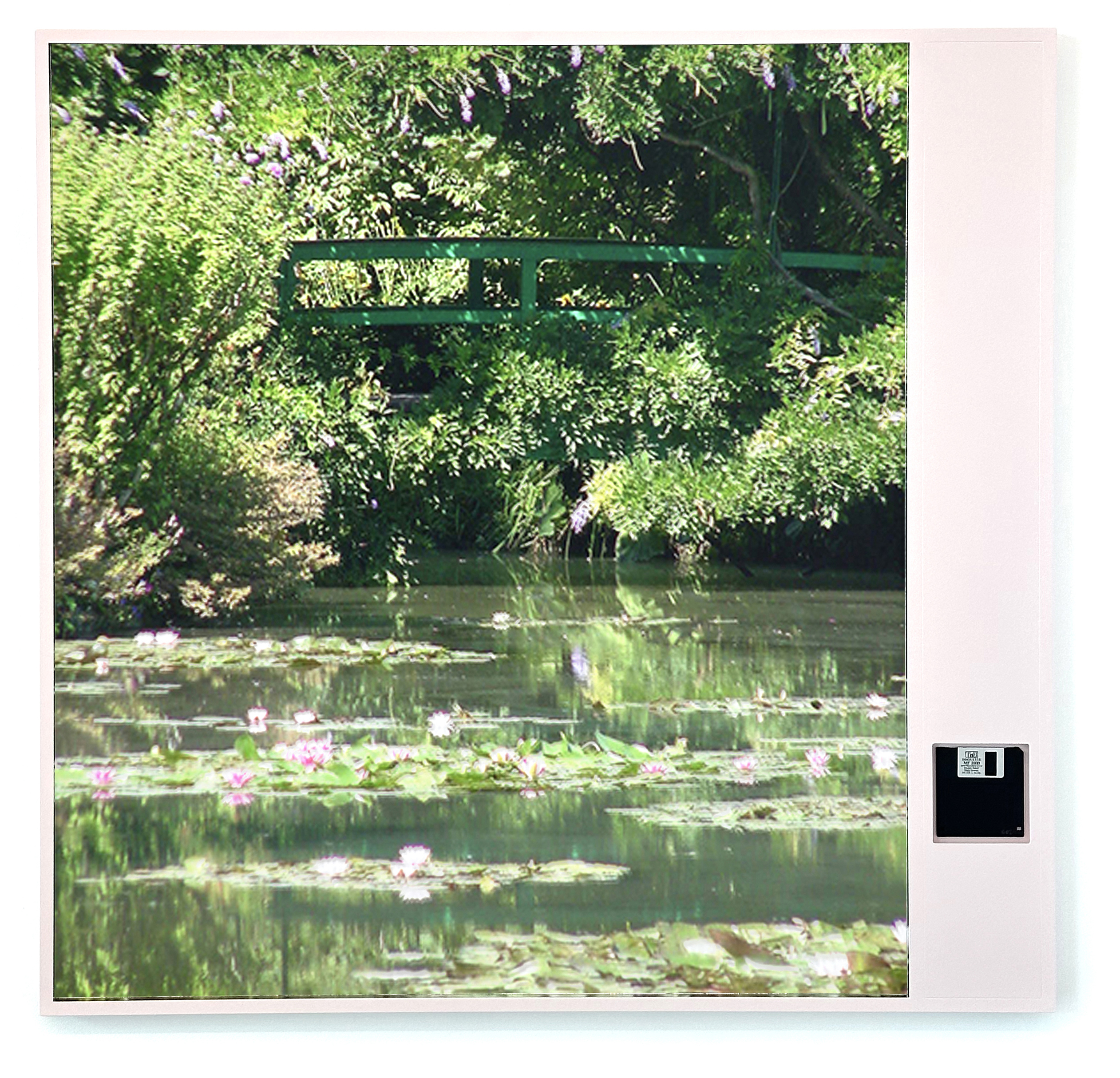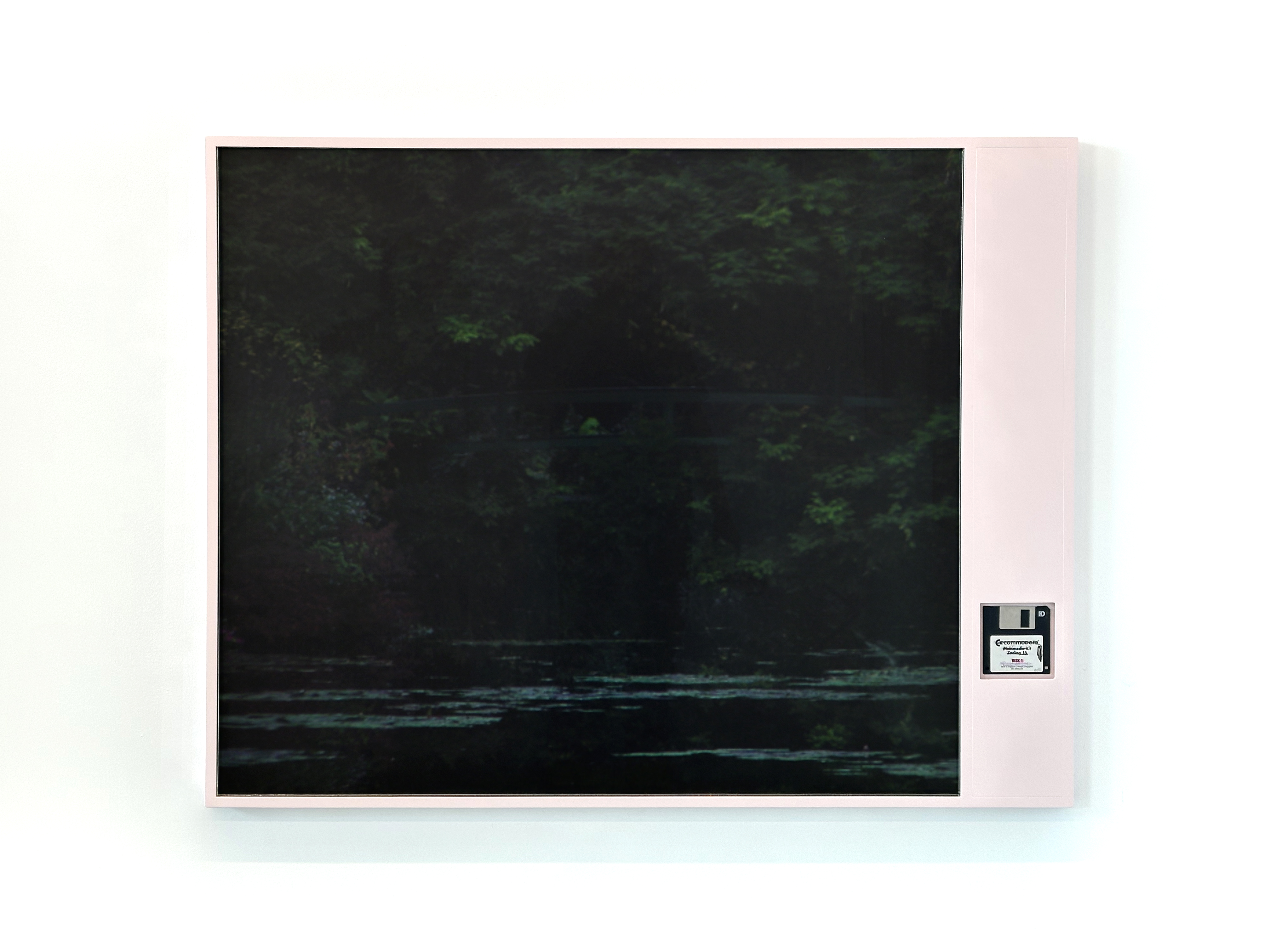
DISK 002, 2023
Custom archival c-print on dibond framed with files on floppy disk
99 x 88 cm / framed 102,5 x 105 cm
Unique piece

























Bridge, 2023
Series of custom archival c-prints on dibond framed with files on floppy disk
When I first visited the water lily pond at Monet's house in Normandy, I came home that evening with a special memory. It wasn't a memory of the place I had visited that afternoon, not a memory of the physical experience of that day, but a memory of a painting I had seen in real life. I remembered the painting of the bridge over the water lily pond. I found it hard to comprehend that this image was stronger than the memory of the physical place where I had been that day.
Perhaps because that painting has occasionally appeared to me throughout my life, on calendars, in books, on coffee mugs, kitchen aprons, and so on. A day later, I decided to look up the painting, to reflect on how it relates to my physical experience from the day before. The painting didn't exist; there were more of them. To be precise, there were 48, of which 24 are considered finished works. I felt the repetition with which the image had presented itself to me throughout my lifetime here again. A series of paintings that all seem to be siblings, each with a small variation.
A study, to get a little more grip each time on how reality before your eyes should relate to what is shown in the replicated version of it. Looking at his works, I can imagine that much of Monet's life revolved around this. After the advent of photography, and with that the disappearance of the necessity of realism in painting, a world of possibilities opened up that needed to be explored.
More than a century later, I stood there, for the first time, with one of the first digital cameras, which would once again revolutionize realism in photography. The countless times I then visited the garden, that long drive again, those roundabouts again, that same road again, through the tunnel, into the garden, the same stream of tourists; I filled floppy after floppy with this early digital relic of a machine (the Sony Mavica from 1997 stores its files directly on a floppy disk). A camera that, compared to its contemporaries, set us back almost a century in terms of realism; the colors are dull, the contrast is strange, the sensor in the device still doesn't know how to handle the light, and the resolution is extremely low. An abstraction of what can be seen in front of the lens, compressed to a JPG of 640x480 pixels. The first camera that didn't produce original material but only data, data that could be distributed directly via its carrier; and that was worth more to many people than a quality image.
During these two years I began to feel what repetition does, looking at the same thing time after time, yet approaching it just a little differently each time. After the first ride, subsequent rides felt monotonous, until I began to notice the small differences. The trees discolored, the roadwork came and went, the landscape changed. So did the garden. I began to understand the need for repetition, to feel the resignation of observing, to take notice of the small changes that show you a bigger picture. The waves of different plants blooming at different times of year, the lilies that show their flowers a little later on a cold day, the absence of tourists in winter, when the plants retreat and the bridge, by now a replica, fully reveals itself...
One last time I walk through the gift-shop to the exit, and of all the types of items you can think of I choose a cap with the bridge on it. I wear it during the last ride back, ending at home on the couch, where I grab my phone, again that access code, again that same app, again that same scrolling.
The project was made possible by the kind support of the Mondriaan Fund, AFK, and the cooperation of Foundation Claude Monet in Giverny.
![]() DISK 008, 2023
DISK 008, 2023
Custom archival c-print on dibond framed with files on floppy disk
88 x 100 cm / framed 91,5 x 117 cm
Unique piece
![]()
Series of custom archival c-prints on dibond framed with files on floppy disk
When I first visited the water lily pond at Monet's house in Normandy, I came home that evening with a special memory. It wasn't a memory of the place I had visited that afternoon, not a memory of the physical experience of that day, but a memory of a painting I had seen in real life. I remembered the painting of the bridge over the water lily pond. I found it hard to comprehend that this image was stronger than the memory of the physical place where I had been that day.
Perhaps because that painting has occasionally appeared to me throughout my life, on calendars, in books, on coffee mugs, kitchen aprons, and so on. A day later, I decided to look up the painting, to reflect on how it relates to my physical experience from the day before. The painting didn't exist; there were more of them. To be precise, there were 48, of which 24 are considered finished works. I felt the repetition with which the image had presented itself to me throughout my lifetime here again. A series of paintings that all seem to be siblings, each with a small variation.
A study, to get a little more grip each time on how reality before your eyes should relate to what is shown in the replicated version of it. Looking at his works, I can imagine that much of Monet's life revolved around this. After the advent of photography, and with that the disappearance of the necessity of realism in painting, a world of possibilities opened up that needed to be explored.
More than a century later, I stood there, for the first time, with one of the first digital cameras, which would once again revolutionize realism in photography. The countless times I then visited the garden, that long drive again, those roundabouts again, that same road again, through the tunnel, into the garden, the same stream of tourists; I filled floppy after floppy with this early digital relic of a machine (the Sony Mavica from 1997 stores its files directly on a floppy disk). A camera that, compared to its contemporaries, set us back almost a century in terms of realism; the colors are dull, the contrast is strange, the sensor in the device still doesn't know how to handle the light, and the resolution is extremely low. An abstraction of what can be seen in front of the lens, compressed to a JPG of 640x480 pixels. The first camera that didn't produce original material but only data, data that could be distributed directly via its carrier; and that was worth more to many people than a quality image.
During these two years I began to feel what repetition does, looking at the same thing time after time, yet approaching it just a little differently each time. After the first ride, subsequent rides felt monotonous, until I began to notice the small differences. The trees discolored, the roadwork came and went, the landscape changed. So did the garden. I began to understand the need for repetition, to feel the resignation of observing, to take notice of the small changes that show you a bigger picture. The waves of different plants blooming at different times of year, the lilies that show their flowers a little later on a cold day, the absence of tourists in winter, when the plants retreat and the bridge, by now a replica, fully reveals itself...
One last time I walk through the gift-shop to the exit, and of all the types of items you can think of I choose a cap with the bridge on it. I wear it during the last ride back, ending at home on the couch, where I grab my phone, again that access code, again that same app, again that same scrolling.
The project was made possible by the kind support of the Mondriaan Fund, AFK, and the cooperation of Foundation Claude Monet in Giverny.
 DISK 008, 2023
DISK 008, 2023Custom archival c-print on dibond framed with files on floppy disk
88 x 100 cm / framed 91,5 x 117 cm
Unique piece
